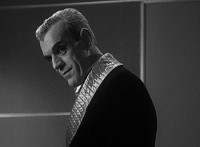| 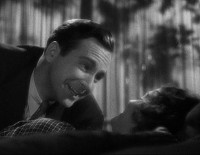 Bela Lugosi as Dr. Vitus Werdegast in The Black Cat 1934 |
Bela Lugosi as Dr. Vitus Werdegast in The Black Cat 1934 |
|—|—|
| Hjalmar Poelzig: Boris Karloff | Dr. Vitus Werdegast: Bela Lugosi | Peter Alison: David Manners |
|  Julie Bishop as Joan Alison in The Black Cat 1934 |
Julie Bishop as Joan Alison in The Black Cat 1934 |
| Joan Alison: Julie Bishop | Karen: Lucille Lund | Directed by Edgar G. Ulmer |
Stepping into the realm of classic horror, The Black Cat from 1934 stands as a haunting testament to the power of atmosphere and psychological dread. Days after watching it, the film’s eerie essence lingers, not through jump scares or overt terror, but through a pervasive sense of unease and surreal logic. It’s a cinematic experience that burrows under your skin, reminiscent of the unsettling moods found in Dreyer’s Vampyr or Dali’s Un Chien Andalou, where the ambiance itself becomes a character, refusing to release its grip. This isn’t just a monster movie; it’s a descent into a disturbing psychological landscape, where even the symbolism of a Naked Black Cat, stripped of its fur and mystique, could represent the exposed vulnerabilities and raw fears at the film’s core.
 Lugosi and Karloff engage in a deadly chess match in The Black Cat (1934)
Lugosi and Karloff engage in a deadly chess match in The Black Cat (1934)
Initially, The Black Cat, the first cinematic pairing of horror titans Boris Karloff and Bela Lugosi, might appear somewhat theatrical to modern viewers. Lugosi’s inherent theatricality can seem exaggerated, and Karloff’s prolonged, silent stares, while effective in The Mummy, could feel repetitive. However, as the narrative unfolds, these initial impressions dissipate. Karloff’s leers transform into menacing sneers, and Lugosi’s probing questions reveal a shared darkness between the characters. They become two sides of a tarnished coin, inhabiting an art deco mansion that seems to amplify their inner turmoil. The film gradually morphs into something profoundly disturbing, a twisted narrative that defies easy categorization.
But let’s not get ahead of ourselves.
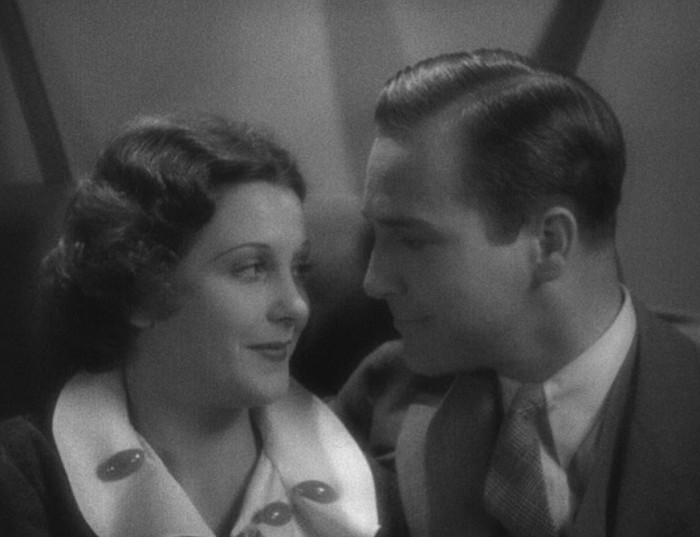 An seemingly innocent couple, Joan and Peter, are about to face existential horror in The Black Cat (1934)
An seemingly innocent couple, Joan and Peter, are about to face existential horror in The Black Cat (1934)
Our story begins on a train bound for Hungary, carrying honeymooners Joan and Peter, an idyllic American couple radiating naive charm. Their romantic dinner in a private car is interrupted by the arrival of Dr. Werdegast as a fellow passenger.
Lugosi’s Werdegast is a complex figure. Presented as the film’s protagonist, Lugosi’s casting itself creates a sense of unease. We learn of his 18 years spent in a Russian gulag after a devastating World War I battle and his quest for revenge against the man who betrayed him and to find his lost family. This sympathy is immediately undercut when he inappropriately touches Joan’s hair as she sleeps.
Werdegast is clearly damaged. Lugosi masterfully portrays a man simultaneously eliciting sympathy and hinting at deep-seated rage and perversion. He embodies tragedy, his performance imbued with a supernatural grace, as if he exists just outside the realm of humanity, longing for connection yet drawn to a dark abyss.
 Dr. Werdegast intrudes on Joan and Peter's train compartment in The Black Cat (1934)
Dr. Werdegast intrudes on Joan and Peter's train compartment in The Black Cat (1934)
This abyss is the dwelling place of Karloff’s Hjalmar Poelzig. Poelzig, a former Hungarian army engineer, betrayed his troops, leading to the massacre of 10,000 men. He now resides in a modernist mansion built upon the very site of the old fortifications, the destination of Werdegast’s vengeful journey.
Peter and Joan are unwillingly drawn into this conflict when a car accident en route to their honeymoon destination leaves Joan injured. The mansion itself is not a stereotypical haunted castle, but a stark, modern structure. Its sleek lines convey futurism yet project an ominous presence.
Karloff’s entrance is impactful. His rapid ascent to horror icon status is playfully acknowledged. “KARLOFF and BELA LUGOSI” appears above the title credits, and his introduction is staged to maximize anticipation.
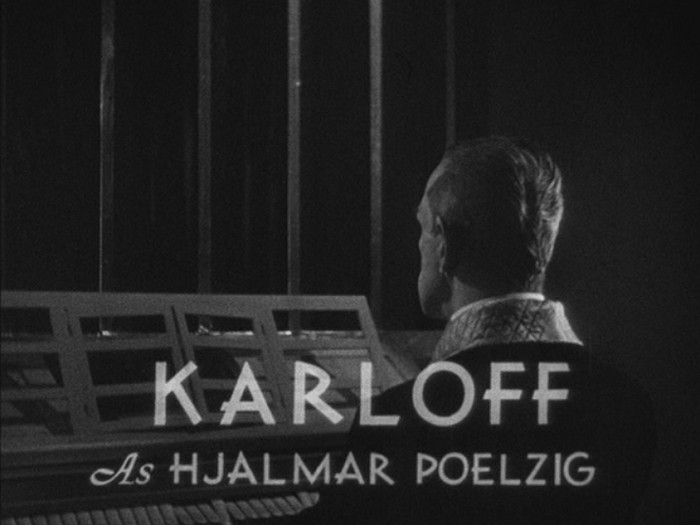 The iconic silhouette of Karloff as Poelzig in The Black Cat (1934)
The iconic silhouette of Karloff as Poelzig in The Black Cat (1934)
Even without seeing his face, Karloff’s presence is instantly recognizable. Unlike Lugosi’s sometimes self-parodying persona, Karloff always exuded menace. His piercing eyes, pointed chin, and chilling smile cemented his status as a cinematic villain.
Poelzig invites the stranded couple to stay, quickly displaying a disturbing interest in Joan. He is revealed to be married to Karen, Werdegast’s daughter, and was previously married to Werdegast’s wife before her death. Adding to his depravity, Poelzig keeps a collection of preserved dead women in glass cases in his basement, a macabre gallery for his twisted admiration. These women, like naked black cats displayed for scrutiny, represent Poelzig’s ultimate objectification and control.
 Poelzig's disturbing collection of preserved women in The Black Cat (1934)
Poelzig's disturbing collection of preserved women in The Black Cat (1934)
Werdegast, feigning civility, bides his time for revenge. Poelzig, after confining Karen to her room, engages Werdegast in a chess game, the stakes being Joan’s freedom versus her potential sacrifice in an upcoming ritual.
Poelzig is also a Satanist, adding another layer to his villainy. He has built his mansion on the graves of his betrayed soldiers, a monument to hubris and disrespect. Yet, there are hints of underlying guilt. He lies to Werdegast about his family and treats him as a guest, suggesting a conflicted sense of kinship with the man he has wronged.
Peter, attempting to be friendly, further thaws the tension between Werdegast and Poelzig. During drinks, we learn of Poelzig’s engineering prowess, Werdegast’s psychiatric renown, and Peter’s less impressive career as a mystery writer – an ironic detail given his ineptitude in the unfolding real-life mystery.
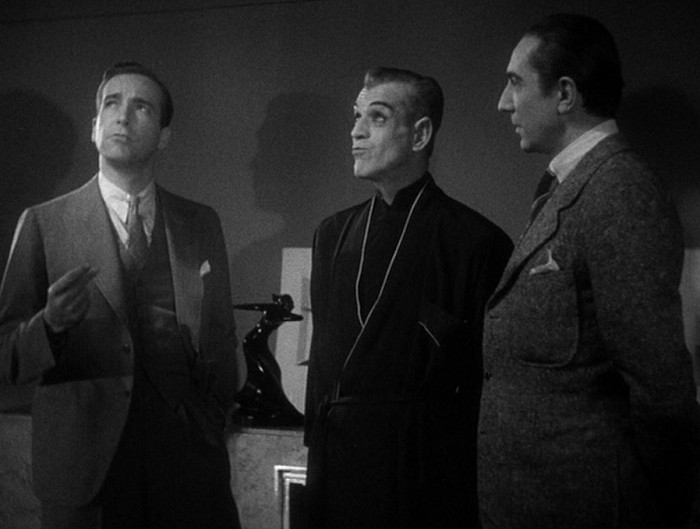
The titular black cat appears, deemed an embodiment of evil and death. Werdegast displays phobic terror, while Poelzig embraces it. The cat, in its traditional symbolism, could be seen as a manifestation of the naked, primal fear that both men embody in different ways.
The chess game culminates, setting the stage for a confrontation between Werdegast and Poelzig on the night of the black mass, where Joan is intended as a sacrifice.
The film’s climax is a series of unsettling moments, culminating in Werdegast’s brutal revenge on Poelzig, depicted only in shadows, leaving the horrific details to the viewer’s imagination, a far more terrifying approach.
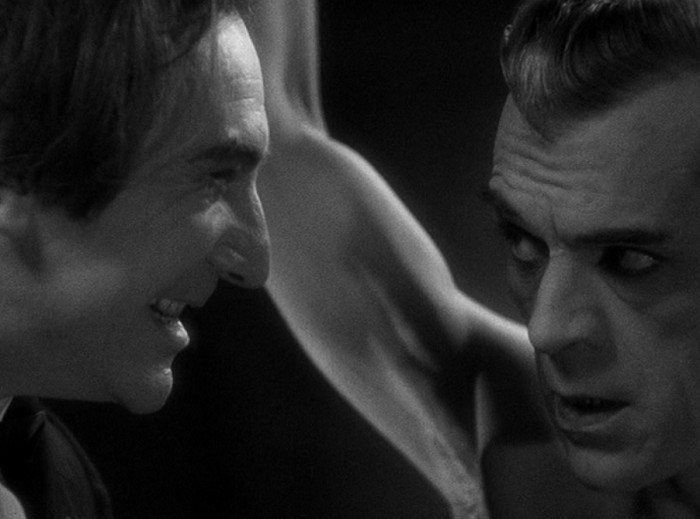 Poelzig is unaware of the vengeance awaiting him in The Black Cat (1934)
Poelzig is unaware of the vengeance awaiting him in The Black Cat (1934)
The Black Cat transcends typical Universal horror fare. Ulmer’s direction, with its stark sets and oppressive atmosphere, creates a palpable sense of terror. The film’s unsettling mood lingers, amplified by its unconventional editing and Karloff’s menacing presence.
Ulmer’s camera work is notable, employing Poelzig’s point of view and unsettling close-ups during the black mass, highlighting the disturbing devotion of the Satanists.
 The foreboding staircase in Poelzig's mansion in The Black Cat (1934)
The foreboding staircase in Poelzig's mansion in The Black Cat (1934)
For Lugosi, Werdegast is a career highlight, a rare opportunity to play a complex anti-hero. Ulmer, seizing his chance at a major studio, crafted a film that represents a final, potent gasp of Pre-Code horror, a period of cinema known for its audacious and boundary-pushing themes.
Unpacking the Meanings
[Spoilers ahead]
Interpretations of The Black Cat are varied. Some see it as a chess match between good and evil, others as a parable about youthful naivete.
Ulmer’s commentary, however, seems more direct: Americans fail to grasp the true horrors of World War I. Peter and Joan remain largely oblivious to the gravity of their situation. Peter, in particular, is consistently inept, even easily defeated by the butler.
 Peter proves himself utterly useless in The Black Cat (1934)
Peter proves himself utterly useless in The Black Cat (1934)
Ulmer, being Hungarian, likely shares a perspective with Poelzig and Werdegast. The film doesn’t portray Peter and Joan as heroes, but as individuals incapable of comprehending the profound horrors they encounter. This suggests a veiled allegory for World War I, where American intervention, according to this interpretation, resulted in destruction and subsequent American obliviousness to the long-lasting trauma.
Peter’s climactic act of shooting Werdegast, albeit in confusion, underscores his ineffectual nature. Joan’s demand to Werdegast, “And you let him live?” after learning of Poelzig’s crimes, is jarringly forceful, revealing a simplistic, black-and-white worldview and a self-centered concern for her own safety.

The film concludes with Joan and Peter’s return, blissfully ignorant and unable to articulate their experience. They dismiss a negative review of Peter’s book as unbelievable, oblivious to the real horrors they’ve just survived. For them, it’s a forgotten memory; for many Europeans, the war’s horrors are indelible.
Supernatural or Baloney?
“Sounds like so much supernatural baloney to me.” “Supernatural… perhaps. Baloney… perhaps not. There are many things under the sun.”
This exchange between Peter and Werdegast highlights a key aspect: the lack of explicit supernatural events in The Black Cat.
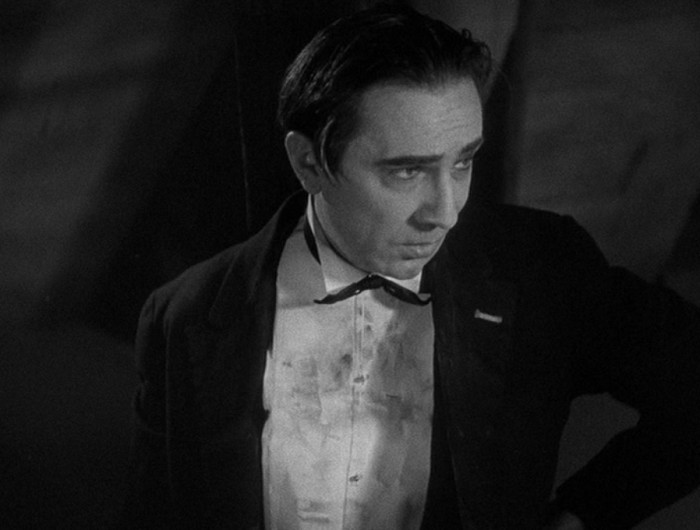
While dialogue might suggest supernatural elements, the film primarily operates within psychological and earthly horrors. The Satanic mass, with cloaked figures, culminates with a woman fainting, seemingly triggered by witnessing Poelzig’s intended sacrifice of Joan.
This fainting woman, and the subsequent chaos, raises questions. Was she truly overwhelmed by a sacrifice, or did she witness something more? Perhaps, as hinted at in the original text, the arrival of a genuinely supernatural force?
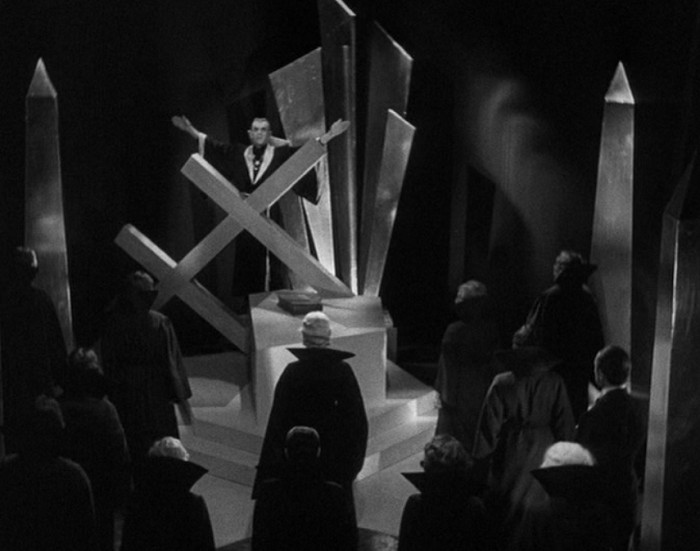 The Satanic altar in The Black Cat (1934)
The Satanic altar in The Black Cat (1934)
While speculative, this interpretation adds another layer to The Black Cat‘s unsettling ambiguity. The film thrives on suggestion, allowing the audience’s imagination to conjure horrors far more potent than explicit depictions.
Pre-Code Proof
- The depiction of Satanism is unusually elaborate and, arguably, appealing for the era.
- Poelzig’s dead women collection strongly implies necrophilia.
- Werdegast suggests Poelzig’s pedophilic interest in his daughter, given the timeline and Karen’s apparent age.
- Werdegast’s casual medical examination of Joan in her pajamas is suggestive.
- Poelzig’s lust for Joan is blatant and disturbing, underscored by his physical interactions with suggestive objects like chess pieces and nude statues.
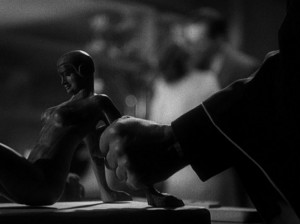 Poelzig's disturbing grasp of a nude statue in The Black Cat (1934)
Poelzig's disturbing grasp of a nude statue in The Black Cat (1934)
Image Gallery
Click to enlarge!
Trivia & Links
- The film’s title is loosely inspired by Edgar Allan Poe’s short story The Black Cat, sharing thematic parallels:
- Poe’s story explores uncontrollable inner darkness, mirroring Werdegast’s emotional turmoil.
- The black cat disrupts Werdegast’s plans, similar to its role in Poe’s story.
- Poelzig’s mansion, built on old fortifications, symbolizes entombment of the past, akin to the protagonist’s attempts in Poe’s story.
- Poelzig’s entombed women, though in transparent cases, echo the entombment theme of Poe’s story.
 Karloff and Lugosi in a tense scene from The Black Cat (1934)
Karloff and Lugosi in a tense scene from The Black Cat (1934)
- Ehsan Khoshbakht’s “Notes on a Cinematograph” delves into the film’s origins and the real-life inspiration for Poelzig, a German architect. He analyzes Ulmer’s transformation of modernist sets into sources of horror.
- Karloff’s Poelzig is rumored to be based on occultist Aleister Crowley. Aleister Crowley’s Wikipedia page.
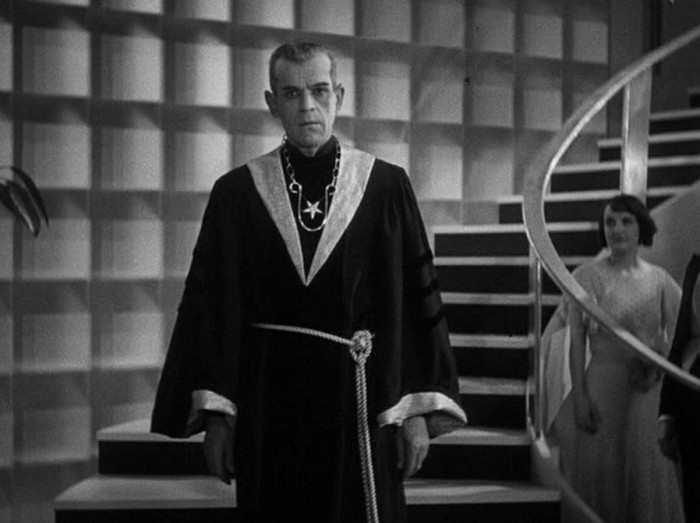
Lugosi reportedly exclaimed during a 1955 revival, “What a handsome bastard I was!”
- AMC’s Filmsite offers a plot summary and notable quotes.
- The driver in the car accident is rumored to be an homage to the doorman in F.W. Murnau’s The Last Laugh (1924), a film Ulmer worked on.
 The doorman from The Last Laugh (1924)
The doorman from The Last Laugh (1924)
- Andre Sennwald’s 1934 New York Times review reflects the initial mixed reception, criticizing it as “more foolish than horrible” and over-the-top.
The final joke hints that normalcy itself is a naive illusion.
- The film’s opening shot emphasizes its theme:
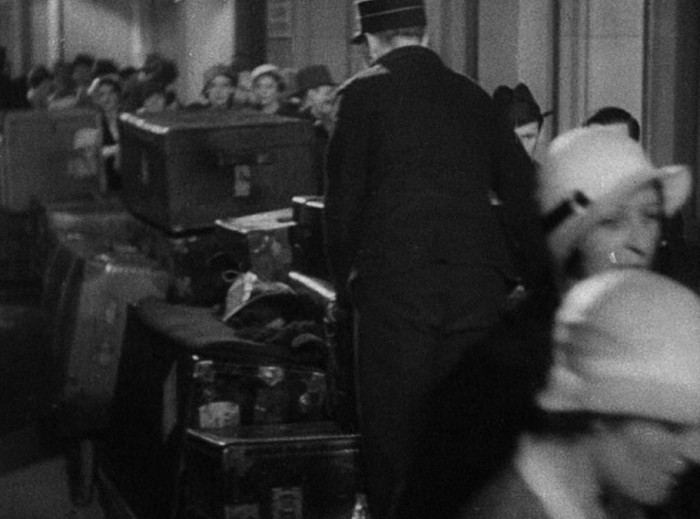 BAGGAGE label in The Black Cat (1934)
BAGGAGE label in The Black Cat (1934)
- Similarities exist between The Black Cat and the cult film Manos: The Hands of Fate (1966), both featuring Satanists with multiple wives and a desire for more.
- Poster roundup:
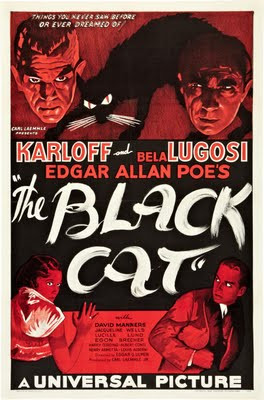 Poster for The Black Cat (1934)
Poster for The Black Cat (1934)
 Poster for The Black Cat (1934)
Poster for The Black Cat (1934)
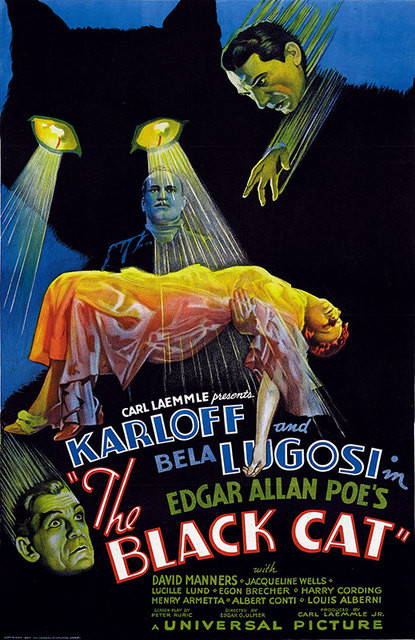 Poster for The Black Cat (1934)
Poster for The Black Cat (1934)
- The dynamite-rigged house is a peculiar plot device, raising questions about 1930s home design trends.
Awards, Accolades & Availability
- Part of the Universal Horror series.
- Universal’s top-grossing film of 1934.
- Available on single-disc Amazon and Classicflix.
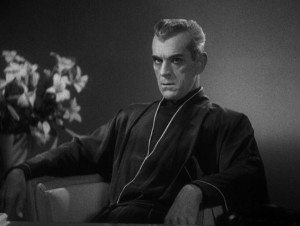 The Black Cat DVD cover featuring Karloff and Lugosi The Black Cat DVD cover featuring Karloff and Lugosi |
|---|
Related Content
Comment below or subscribe via email! Home | All Reviews | What is Pre-Code? About | Follow on Twitter

